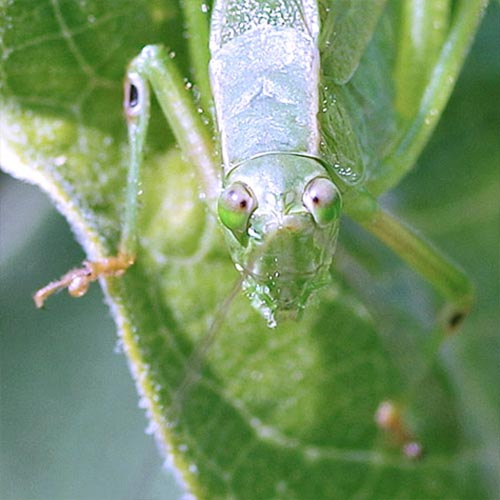Greetings, BugFans,
Tree crickets have been so loud in the fields that the night calls of migrating birds are drowned out. In honor of another group of singing Orthopterans, the BugLady is rerunning this 2009 episode about Katydids (with a few fresh pictures).
Katydids
Katydids are classified in the order Orthoptera (straight wings) and in the family Tettigoniidae, the Long-horned Grasshoppers and Katydids. In order to belong to this club, your antennae have to be as long as or longer than your body. These are large, beautiful, green insects of grasslands, open woods and edges whose often ventriloquistic calls can be heard both day and night (brown and pink morphs also exist). True katydids, bush katydids, conehead katydids, shield-backed katydids, and meadow katydids all belong in the Tettigoniidae.
[metaslider id=2312]
The BugLady suspects that her photos are (mostly) of bush katydids in the genus Scudderia, but she is not going to climb out any farther on the taxonomic limb than that. Male bush katydids are hard to tell apart, and the even-more-difficult-to-identify females are known by the company they keep. Bush katydids have wings that are much longer than their abdomen.
Sue Hubbell, in Broadsides from the Other Orders, discusses the origin of the word “Katydid.” Katy is an old word for “a wanton,” and there are associated folk stories/songs about wronged and vengeful women and what they did or did not do about it, and katy-did/didn’t echoed society’s debates about their (alleged) guilt. But John Bartram, explorer of the American southeast and contemporary of Ben Franklin, called this insect the “Catedidst,” an allusion to catechesis or instruction by word of mouth, which in turn comes from a Greek word meaning to resound or to din in one’s ears. Ah, the etymology of entomology. One entomologist quoted by Hubbell suggests adopting a family name Katydididae, but no one has taken him up on it yet.
During mating, the male passes a bubble-like sperm packet (spermatophore) to the female; along with his genetic material, this contains protein for her to feast on and use in the development of her eggs. These packets are expensive; according to Kaufman and Eaton in the Field Guide to Insects of North America. The male “spends” as much as 40% of his body weight producing them, and after he hands over a spermatophore, he grazes avidly. Hubbell says that during hard times, when vegetation is sparse, females actively pursue the suddenly-shy males. Because of the high cost (his physiological investment is greater than hers), he is not a wanton.
[metaslider id=2313]
In late summer or fall, eggs are deposited in or on vegetation via ovipositors that are long and saber-like or short and sickle-like, and they hatch the following spring. Katydids, like other members of the grasshopper clan, practice Simple/Incomplete metamorphosis, and newly hatched nymphs look like their elders and eat the same foods. Most katydids nosh on vegetation, but some species are predaceous on other insects, and cannibalism is not unknown. Nymphs lack the adults’ wings and reproductive organs; these gradually appear as the nymph grows and sheds, and males start to sing as they become sexually mature. The BugLady guesses that the katydid doing chin-ups had shed recently or is about to shed. Its wings extend almost half the length of its abdomen, which suggests that it has only a few more molts before adulthood.
Being large, abundant, harmless and tasty, and in spite of their excellent camouflage (well, except for the pink ones, and the BugLady seriously wants to find a pink katydid), they are an important food for birds, including owls and kestrels, and for rodents, spiders and other insects.
Male Katydids are all about sound (in some species, the females answer, but not loudly). And if their hind set of wings is dedicated to flight, their front pair was made for song. This they accomplish by stridulation (friction), rubbing the rigid edge of one forewing against a comb-like “file” on the other. What they produce may not sound like the classic “katy-did, katy didn’t;” that song is limited to a single genus of “True Katydids.” Fork-tailed Bush Katydids are the best singers of the “false katydids”, with a repertoire of clicks and buzzes. Because those who produce sound must be able to hear it, katydids have a slit-like “ear” (tympana) on each front leg. To pick up sound, they raise a leg in a gesture that is reminiscent of humans cupping their hand behind an ear.
Calls are designed to attract females of their own species and to minimize attraction by other species, and yet if katydids were classified by calls alone, more species would be listed than when they are separated strictly by physical characteristics.
Hubbell says that Katydids challenge us to reevaluate our concept of “sound,” because in addition to the clicks and buzzes, some kinds of katydids have an ultra-ultrasonic call, while others produce, by thumping/stamping on twigs in species-specific tempos, vibrations that are detected by other katydids. For many insects there is no line between “heard” and “felt,” and the vocabulary of our sensory experience may be inadequate to express theirs.
The BugLady
